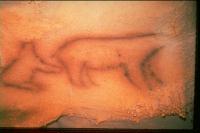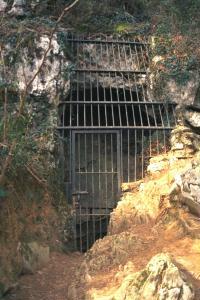Reproduction of prehistoric paintings in Ekain

As the sheep Dolly is a faithful copy of its pioneer, the new Ekain being built in Zestoa will be the twin of the original cave. The techniques used for the elaboration of decorations in the cinema have been based on the reconstruction of the walls and paintings of the cave, so that the visitors who approach it have an impression on being in Ekain.
In June, in 1969, the members of Aranzadi met the decision to close the cave, aware of the importance of their treasure. In Ekain you can see a spectacular collection of paintings of the men of the Madeleine period: images and engravings of horses, deer, bison, bears, etc., in different galleries of the cave, being the horse the most frequent image. Since its discovery, Ekain has remained closed, which has allowed to preserve its images and engravings in the same conservation conditions as those found. In the numerous caves visited, in the place of Santimamiñe, the rock art has suffered enormous damage by the respiration of the visitors and the bacteria and fungi that we transport with us. In June, however, the measures taken have avoided such problems.

The strict measures of protection of rock art, however, leave in the hands of a few such an important legacy. For the preservation of the paintings it is necessary to keep them out of the eyes of the visitors and, therefore, lose a unique opportunity to know in situ our past. But why save what can't be seen? Aware of this paradox, the Town Council of Zestoa launched a project of replica of the cave of Ekain. The project is at a good pace and can be completed for the spring or summer of next year.
The replica of the cave of Ekain has been realized applying the fac-simile technique used previously for the realization of replicas of the winds of Altamira, Lascaux and Niaux. The technique, based on photography, allows to reconstruct the original work to real size, in three dimensions and with all precision.
The first step of the work is to collect data on the original cave. For this purpose, the data of the relief of the wall is collected using the technique called stereofotometry, that is, three-dimensional photographs are made and worked by computer. The correct collection of the data is essential to be able to make a faithful copy, so this first step can be long, especially when, like in Ekain, the relief presents great variations. Compiled and elaborated this data, the second step consists of the reconstruction of the walls on a scale using the aforementioned fac-simile technique. In short, the photographs in three dimensions collected are projected on the wall to model and a calco of the seen is carried out. But although the principle of the technique is simple, the work to be done is immense, since it is worked with a precision of centimeters.
The polyester plates to make the wall join one after the other. Using the data collected by the computer, it is given the form corresponding to each sheet, obtaining the general profile of the wall. Then, by hand and with patience, you have to match all the layers in order to do what will be the original wall mold.
In the second phase the mineral restoration of the wall is carried out, copying in detail the relief of the original cave. For this purpose, acrylic compounds are used based on natural materials (sand, clay, silica, etc. ). These compounds are easy to handle and serve to invisibly attach the parts of the wall that have been worked separately. In addition, they are flexible, that is, using different varieties of acrylic compounds, the transitions of mineral compositions that are given in mineral walls can be copied with complete fidelity.
Once the wall is made, the most artistic part of the work begins: the reproduction of images. Once again, as in the relief of the wall, projections of three-dimensional photographs are used. The image is projected on the wall and the painter is silent. Natural substances are again used to respect the original colors: land, coal and natural oxides are the same as prehistoric painters.
The copy thus obtained and the original are inseparable for the unknown spectator and for the eyes of the wise. In the case of the months of June, the replica will be composed of copies of three large groups of painting. Next to the walls the floor will also be copied and everything will be rounded with a set design that will make the viewer feel in the original cave.
The water, an important element in Ekain, will play a special role in this scenography. In Ekain an intimate atmosphere has been sought, a replica more than a cathedral.
Cathedral of rock art
The French cave of Lascaux and the spectacular images that form the cathedral of cave art, together with the cave, were discovered in 1940. The walls of Lascaux are filled with figures of bulls, drawn on and next to each other; the prehistoric painters used the colors and relief of the wall with an immense mastery to make bulls figures with their own life. The largest painted bull has 5 meters from end to tail, a spectacular image. The cave was closed in 1963, but since 1983 the above images can be seen in the replica of Lascaux II, located 200 meters from the original Lascaux. Abandoned thinning has become a cave with the same temperature and humidity as the original of Lascaux, and the existence of replica does not detract from what can be seen in it.
Buletina
Bidali zure helbide elektronikoa eta jaso asteroko buletina zure sarrera-ontzian











